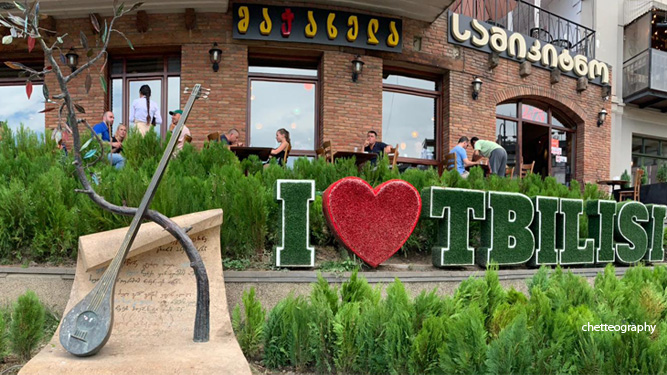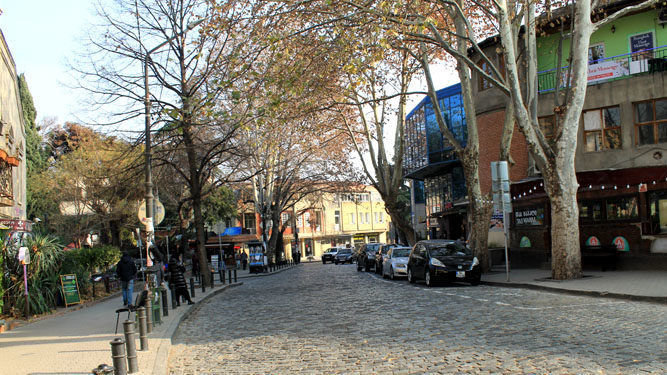
Sightseeing Tbilisi
While there are many ways to see Tbilisi where older traditions and newer fashions have been interacting harmoniously for many centuries, one of the most recommendable ways is to venture out to the streets on your own so that you feel the pulse of the most bustling city of the Caucasus. This tour offers a way to create an overall impression of its history, architecture and atmosphere.
GEORGIAN NATIONAL MUSEUM.
SHALVA AMIRANASHVILI MUSEUM OF FINE ARTS
1| 4, A. PUSHKINI STREET.
Working hours: Everyday except Monday, 11.00 – 16.30
The museum preserves approximately 900 hundred thousand exhibits from the medieval period up to the XX c. and few materials of the pre-Christian period. The Museum is distinguished for its Georgian goldsmith pieces dated back to the VIII-XIX Centuries. The most significant exhibits include the icon of Zarzma Monastery, the Chalice of Bedia, Anchistkhati and Khakhuli Triptychs, etc. The museum also houses the unique exhibits of vitreous enamel, jewelry and art textiles, medieval architecture monuments, paintings, mosaics, statues, etc. Visitors are encouraged to inquire for special passes to access the special Gold Funds exhibiting the greatest masterpieces of the museum’s treasures of the Christian era.
GEORGIAN NATIONAL MUSEUM.
2| 3, RUSTAVELI AVENUE.
SIMON JANASHIA MUSEUM OF GEORGIA
Working Hours: Everyday except Monday-10:30-17:30
The museum houses hundreds of thousands of Georgian and Caucasian artifacts of archeology and ethnography. After the reconstruction the most valuable exhibits of the museum include the Gold Treasure which consists of the unique collection of the pre-Christian goldsmith pieces (III millennium BC-IV century AD); The hall of the Soviet Occupation – displaying archive documents, photo and video materials following the timeline of Georgia’s history from the short-lived independence between 1918 and 1921 to the Soviet army crackdown in 1989 and the declaration of Georgia’s independence in 1991; The collection of the famous photographer Dmitri Ermakov comprises a large quantity of photographs, negatives, albums and photographic equipment illustrating a great variety of people and places in the Caucasus and Asia Minor of the late 1800s and early 1900s; The National Gallery where I half of XX century Georgian art masterpieces are displayed.
LADO GUDIASHVILI EXHIBITION HALL
3| 11, L. GUDIASHVILI STREET
Working Hours: 11:00-18:30; Everyday except Monday
Two dictatorial systems Marxism-Leninism and Fascism brutally destroyed free thought and humanistic values over the years. As an artist, Lado Gudiashvili could not tolerate the horrible reality and expressed the protest by creating a series of satirical graphic works which later became one of the important elements of Georgian visual art. Upon the initiative of the artist’s family, the part of the living space has been turned into an exhibition hall displaying Lado Gudiashvili’s artworks.
KASHVETI CHURCH
4| 1, RUSTAVELI AVENUE
The Kashveti Church of St. George is a Georgian Orthodox church in central Tbilisi, across the Parliament building in Rustaveli Avenue. The name “kashveti” is derived from Georgian words kva for “a stone” and shva “to give birth”. Legend has it the prominent 6th-century monk David of Gareja, of the Thirteen Assyrian Fathers, was accused by a woman of making her pregnant in Tbilisi. David prophesied his denial would be proved when she gave birth to a stone. She did, and the place received the name of “k(v)ashveti”. The church stands out for its beautiful decoration of the altar painted by the prominent Georgian artist Lado Gudiashvili in 1947.
GEORGIAN NATIONAL PICTURE GALLERY
5| 11, RUSTAVELI AVENUE
Working hours: every day except Monday, 11.00 – 18.00
The former ‘Cathedral of Glory’ or a military and history museum was built in 1888-92 as a prototype of the Exhibition Palace in Rome and has served as a picture gallery since the 1930s.
6| MTATSMINDA AND MAMADAVITI CHURCH
The history of the Mamadaviti (Father David) Church takes start from the 6th c. when Assyrian Father David of Gareja cut out a small cave in the hill erected in the west of the town and made a small chapel nearby. According to a legend, Father David prayed to God to give him a spring of water that could cure various diseases and he was granted the wish. Soon after Father David left Tbilisi and moved to Gareja, but Tbilisi inhabitants preserved the respect and gratitude they felt for him for centuries and gave his name to the mountain. The church is surrounded by a terrace serving as a pantheon of famous writers and poets. The curative spring still flows nearby. Mtatsminda is also a popular place, especially in summer, and Tbilisi inhabitants frequent its beautiful park and amusement facilities to escape the heat of the city.
1| NARIKALA
AND THE CHURCH OF ST. NICHOLAS
Narikala is the ancient citadel overlooking the capital of Georgia, and the Mrkvari river. The fortress consists of two walled sections on a steep hill between the sulfur baths and the botanical gardens of Tbilisi. On the lower court there is the recently restored St Nicholas church. The fortress already existed by the 4th century as Shuris-tsikhe (i.e., “Invidious Fort”) and considerably expanded by the Umayyads in the 7th century and later, by King David the Builder. The Mongols renamed it “Narin Qala” (i.e., “Little Fortress” in Persian). Most of extant fortifications date from the 16th and 17th centuries. In 1827, the fortress was damaged by an earthquake and partially demolished.
2| TBILISI BATHHOUSES
The Sulfur Baths are located in Old Tbilisi, on the other side of the river, opposite Darejani Palace, and are known for their tranquillizing effect. After taking in the cathedrals and museums of Tbilisi, reward your weary body with a soak in one of the city’s famous bathhouses. A deep sulfur spring feeds the city with naturally heated mineral water, and bath houses have proliferated across the city for more than a thousand years, offering residents and visitors the opportunity to wash away the stresses of the day. A soak in a sulfur bath is still very much a Tbilisi ritual, a tribute to the pheasant boiled in the naturally hot water spring, which gave start to the city and its name as well (‘tbili’ meaning ‘warm’ in Georgian). While the bathhouses have existed here for more than a thousand years, the extant baths were mainly built in the 17-18th c. and bear strong resemblance to Islamic architecture.
3| TBILISI MOSQUE
The eight angled Minaret of the brick mosque draws the attention even from the far distance and is perceived in a different ways from the various sides. The originally Sunni mosque, located at the end of the Botanical garden is the only functioning mosque in Tbilisi at present, after the Shiite Mosque on the other bank of the Mtkvari was destroyed by communist rulers. Now it serves Shia as well as Sunni Muslims which is extremely rare in any country of the world.
4| BOTANICAL GARDEN
Occupying the area of 161 hectares, its history spans more than three centuries. It was first described in 1671 by the French traveler Jean Chardin as royal gardens which might have been founded at least in 1625. Its extremely rich collection includes floral species from the Mediterranean, North America, China and Japan, the Himalayas, Turkey and Siberia, as well as rare species, such as dark red Maiko peonies and Iberian irises that are virtually no longer extant in the wild nature.
1| BAMBA (COTTON) ROW AND CHARDIN STREET
Once part of the Old Tbilisi bazaar, Chardin Street and the arched Bamba Row even now form a true ‘Diagon Alley’ of the Georgian Capital. The streets offer the best night life spots, such as restaurants, cafes, night bars in the city and seasonally host local and international open air festivals, concerts and galleries.
TBILISI HISTORY MUSEUM, FORMER KING ROSTOM’S CARAVANSARAY.
2| 8, SIONI STREET
Working hours: Everyday except Monday, 10.00 – 18.00
The museum houses over 50 thousand exhibits. They reflect Tbilisi history from the end of the IV millennium to this date. The museum presents archeological, ethnological and documental materials as well as the pieces of national and applied arts, a rich photo-collection etc. A number of unique works of artistic and graphic arts are also preserved in this museum. Together with the old works the museum also exposes the pieces of contemporary art.
SIONI CATHEDRAL.
3| 4, SIONI STREET
Sioni Cathedral is situated in historic Sionis Kucha (Sioni Street) in downtown Tbilisi, with its eastern façade fronting the right embankment of the Mtkvari River. It was initially built in the 6th-7th centuries and was multiply restored. Sioni Cathedral was the main Georgian Orthodox Cathedral and the seat of Catholicos-Patriarch of All Georgia until the Holy Trinity Cathedral was consecrated in 2004. However, it still holds the venerated Grapevine cross (exhibited at the left of the altar) forged by Saint Nino, a Cappadocian woman who preached Christianity in Georgia in the early 4th century. Sioni Cathedral was the place where the Russian Imperial manifesto on the annexation of Georgia was first published on April 12, 1802, when the Russian commander-in-chief in Georgia, General Karl von Knorring, assembled the Georgian nobles in the Cathedral surrounded by Russian troops. The nobles were forced to take an oath to the Russian Imperial crown and any who disagreed was taken into custody.
4| 47, LESELIDZE STREET SYNAGOGUE.
Georgian Jews are one of the oldest communities in Georgia, tracing their migration into the country during the Babylonian captivity in 6th century BC. In Tbilisi Jewish Diaspora was mainly concentrated in Lower Kala and operated several synagogues in the city. The synagogue in Leselidze Street was built in 1910 and is still functioning.
5| PEACE BRIDGE
Straddling the Mtkvari river in Tbilisi, Georgia, is a new pedestrian bridge, courtesy of Italian architect Michel De Lucchi and French lighting director Philippe Martinaud. The structure is composed of glass and iron connecting Old Tbilisi with the new district, and boasts a 150m roof of steel and glass.
The bridge provides a unique old Tbilisi view .It also possesses an interactive light display system. 30,000 LEDs and 240 sensors installed within the structure convey specific messages, scrolled across the two parapets of the bridge every hour. According to the Georgian president, Mikheil Saakashvili the Peace Bridge is a symbol of Georgia’s way from the past to the better future.
JVRISMAMA (CROSS FATHER).
6| 41, LESELIDZE STREET
The Church of St. Cross known to the public as Jvrismama Church is situated in Lower Kala, at the corner of Leselidze and Jerusalem Streets. Tradition holds it that it was initially King Vakhtang Gorgasali who built a church here naming it after Golgotha. The present church was built in the 16th c.
7| ANCHISKHATI BASILICA
The Anchiskhati Basilica of St Mary is the oldest surviving church in Tbilisi, situated in Shavteli Street of Upper Kala. Built in the 6th c. the church is a three-nave basilica. Originally dedicated to the Virgin Mary, it was renamed Anchiskhati (i.e., icon of Anchi) in 1675 when the treasured icon of the Savior created by the twelfth-century goldsmith Beka Opizari at the Anchi was moved to Tbilisi to preserve it from an Ottoman invasion. The icon was preserved at the Basilica of St Mary for centuries and is presently on display at the Art Muse
RIKE PARK
The new recreation complex on Rike square is laid out on 10 hectares in the historic district of Tbilisi. It has a shape of Georgia’s map in which different regions are connected to each another with pedestrian pathways. There are Amphitheatre and children`s square too.
The park is distinguished with its dancing and musical foundation designed by Spanish architect. Rike Park is already open for tourists and residents of Tbilisi, although its final rehabilitation will be completed in 2012.
9| METEKHI
The historical heart of the city, Metekhi is the place from where King Vakhtang Gorgasali started to develop the new capital erecting the first church on top of the hill in the 5th c. Tradition holds that it was also a site where the 5th-century martyr lady Saint Shushanik, the heroine of the oldest known Georgian piece of literature, was buried. Later kings chose the site to host their court, royal palace, fortress and a cathedral here and it remained the royal residence right through Queen Tamar’s reign until Khwarezmid invasion headed by Jalal ad-Din in 1226 left Tbilisi in ruins and its Isani district, including this gorgeous hill-top ensemble, in flames. The extant Metekhi Church of Assumption, resting upon the top of the cliff, was built by the Georgian king St Demetrius II circa 1278–1284 and is somewhat an unusual example of domed Georgian Orthodox church. It was later damaged and restored several times. Metekhi is a must-see for any new visitor to Tbilisi.
10| DAREJANI PALACE AND CHURCH OF TRANSFIGURATION
Another popular attraction, the colorful Darejani Palace or Sachino Estate is also nested on the cliff, next to Metekhi Church. In the 18th c. Queen Darejan, the wife of King Erekle II had the palace edified as her summer residence and had a chapel of the King’s and Queen’s Saints – Erekle and Daria – built beside it. A Theatre during the Soviet era it has been a functioning Convent since 1991.
11| SAMEBA CATHEDRAL
The main cathedral of the Georgian Orthodox Church presents a gorgeous view from various points in the city. This magnificent ensemble was built where once was the Church of St. Elias and consecrated on 3 March 1996.
©GEORGIAN NATIONAL TOURISM ADMINISTRATION






